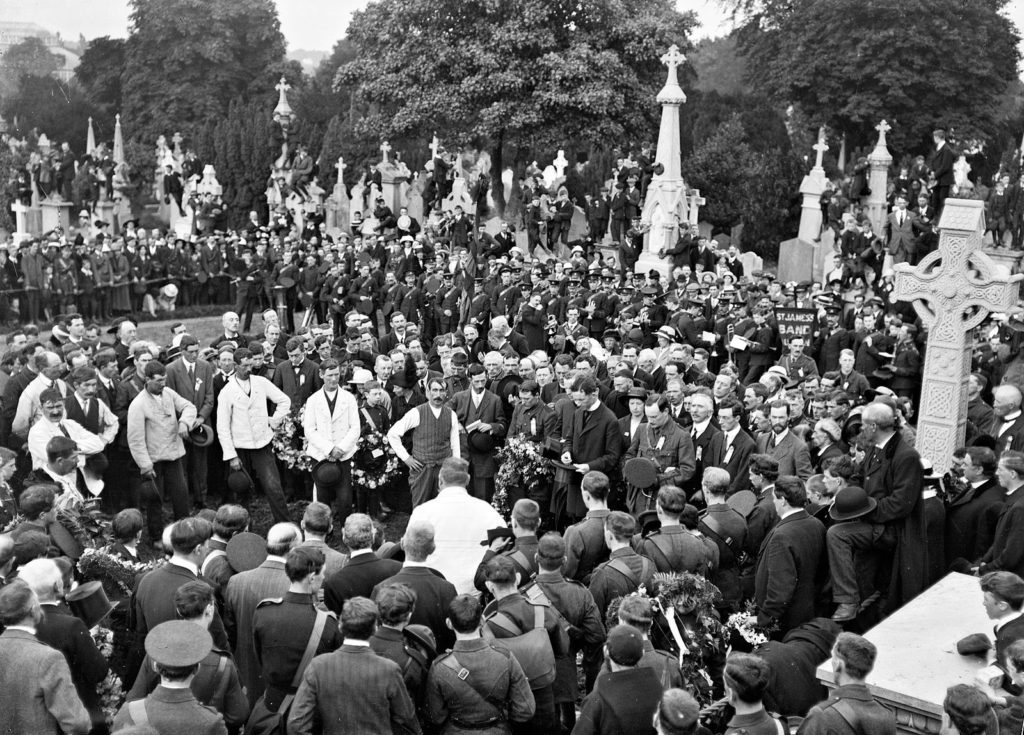By the turn of the 20th Century, new Irish rebellion movements emerged that inspired a collective longing for national independence. A political party named Sinn Fein fostered by Arthur Griffith advocated for Irish nationhood. But while Griffith and others became the public faces of Irish nationalism, another, more radical group called the Irish Republican Brotherhood (IRB) worked in the shadows.
By 1915, a group of IRB members were working on actionable plans for revolution. Those plans had started to coalesce when Patrick Pearse spoke at a funeral on August 1, 1915. Many Irish historians have said that speech was the match that lit the straw.
Outside of Ireland and within, other movements were brewing as well. Throughout the industrialized world, labor and socialist movements were gaining momentum as workers demanded better economic and working conditions. A bitter Irish labor dispute in 1913 fueled the atmosphere of discontent.
Pearse was a poet, a nationalist, an IRB member, and a revolutionary. The power of his influence is captured in his closing remarks at the funeral of fellow IRB member Jeremiah O’Donovan Rossa.
He said, “Life springs from death; and from the graves of patriot men and women spring living nations. The defenders of this Realm have worked well in secret and in the open. They think that they have pacified Ireland. They think that they have purchased half of us and intimidated the other half. They think that they have foreseen everything, think that they have provided against everything; but, the fools, the fools, the fools! They have left us our Fenian dead, and while Ireland holds these graves, Ireland unfree shall never be at peace.”
The speech gained true power when it was published.
Pearse’s words had captured the imaginations of countless Irish people. Over the months that followed a group called the Irish Volunteers, which Pearse led, finalized plans for battle against Great Britain. They had hoped that with Great Britain already heavily engaged in the first World War, that 1916 could be the best time to confront a lighter force in Ireland.
That calculation, however, could not compensate for their own lack of training, organization, funding and arms. They were so disorganized that they didn’t even fully inform all of their own senior leaders of the timing of the insurrection until just a few days beforehand.
Still, the Rising commenced. On April 24, 1916, the seven signatories of a freshly printed Proclamation of Independence led their battalions into war and almost certain annihilation. In about a week, roughly 500 died, and 2,500 people were wounded, mostly civilians and mostly in Dublin. The Volunteers surrendered to avoid creating any further civilian casualties.
As military battles go, the Rising was a failure. All seven signatories of the Proclamation were executed by firing squad, eight more were shot. Another was hanged. Sixteen were executed for their roles in the insurrection. But in the coming years, the Rising and the Proclamation would serve to rally the majority of Irish people to support separation from Great Britain. This in turn led to the Irish War for Independence and then the Irish Civil War.
Unlike America, Ireland never obtained complete independence from Great Britain. But at the end of the Irish Civil War in 1921, the Anglo-Irish Treaty was signed and finalized on January 7, 1922, creating the Irish Republic as we know it today. And it all may have been sparked by a graveside speech given on August 1st. ♦
_______________
This article has been abbreviated from its original publication by the Pittsburgh 1916 Easter Rising Committee. Read the whole piece here.
James J. Lamb is the President of the Ireland Institute of Pittsburgh and Honorary Consul of Ireland, Pittsburgh. Over the next months in Pittsburgh, Irish individuals and organizations throughout Western Pennsylvania will use the 100th anniversary of the Easter Rising as an opportunity to learn, remember, discuss and contemplate the future of Ireland through a series of educational and cultural programs and events. All are welcome to join for the conversation. To learn more about the events visit pittsburghremembers1916.com.


The accuracy of Pearse’s prediction, “Ireland unfree shall never be at peace” was very much in evidence during the North’s 30 years of Troubles (21969-99). The North’s current system is largely peaceful, but that region of Ireland is still rather volatile as it continues to be ruled by a foreign power.